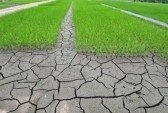Don't Forget to Water Your Slab!
Posted by Janet Owens on Thursday, June 23rd, 2011 at 6:45pm.
 We're experiencing one of the hottest, driest summers in history. We all know we need to water our plants and yards but even more importantly, we need to keep the foundation under our homes moist.
We're experiencing one of the hottest, driest summers in history. We all know we need to water our plants and yards but even more importantly, we need to keep the foundation under our homes moist.
Texas soils are expansive soils that act like a sponge, swelling as they absorb water and shrinking as they lose water. Soils tend to dry out and shrink during the summer and absorb water during the winter and spring.
As the soil under a home shrinks and swells with the seasons, the foundation will shift or move. As long as the foundation movement is not great enough to damage the house or foundation, you will not have a problem. However, if the movement is great enough to crack the slab, you have a huge problem. It's expensive to repair and will affect the resale value of your home.
To prevent seasonal house and foundation damage, you should follow a controlled watering program. By keeping the soil under the foundation constantly moist, you can often stop the foundation movement. The goal is to maintain a constant level of moisture in the soil under the foundation.
The best way to water the foundation is to install a buried foundation watering system. If you don't want the expense of such a system, a much cheaper way to keep the soil moist is to bury a soaker hose 3 inches deep and 6" away from the edge of the foundation. short distance from the foundation will allow the water to evenly soak into the soil.
Do not put the hose against the foundation. When the soil is dry and cracked, water can travel along the cracks for several feet in all directions. If the soil around the foundation is dry and cracked then water next to the foundation will run through the cracks and accumulate at the bottom of the grade beam. In some cases, an accumulation of water in the soil at the base of the foundation can cause the soil to lose some of its load bearing capacity. If the soil loses its load bearing capacity, the house will sink into the ground.
Obviously it's necessary to water more during hot, dry weather and less during cold, damp weather. The amount of water required to keep a foundation stable during the summer can be surprisingly large. A single large tree can remove as much as 150 gallons of water from the soil each day. Shrubs and other plants can also remove large quantities of water. During the persistent hot dry weather like we're experiencing, it may be necessary to water a foundation each day.
Watering should supply enough water to keep the moisture content in the soil under the foundation constant. If the amount of water applied is only enough to keep the surface damp, the watering program will not work.
You are the only one who can weight the benefits of controlling foundation movement versus the increased size of the water bill. But keep in mind, there is a tremendous cost to repair a cracked slab as well as a decrease in the home's value. The cost of prevention may be well worth it.

